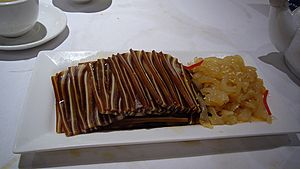Lou mei facts for kids

Pig ears (left) with Jellyfish (right)
|
|
| Course | Hors d'oeuvre |
|---|---|
| Place of origin | Taiwan |
| Main ingredients | offal |
| Lou mei | |||||||||||||||||||
|---|---|---|---|---|---|---|---|---|---|---|---|---|---|---|---|---|---|---|---|
| Traditional Chinese | 滷味/鹵味 | ||||||||||||||||||
| Simplified Chinese | 卤味 | ||||||||||||||||||
| Hanyu Pinyin | lǔwèi | ||||||||||||||||||
| Cantonese Yale | lóuh méi | ||||||||||||||||||
|
|||||||||||||||||||
Lou mei is a yummy type of food from China that's cooked in a special sauce. This sauce is called a "master stock" or "lou sauce." It's like a super flavorful broth that makes the food taste amazing! In Taiwan, this dish is often called lu wei.
Lou mei can be made from different kinds of meat. This includes parts like beef, pork, duck, and chicken. Sometimes, it's even made with other parts of animals that people usually don't eat, like organs. There's also a special kind called zaai lou mei in Hong Kong. This version is made for vegans and uses plant-based ingredients like wheat gluten instead of meat.
Lou mei started in Southern China. It's a big part of Hokkien and Teochew cuisine. You can find it all over China and Taiwan, with many different local styles. When you visit a Chinatown in other countries, you'll often see different kinds of lou mei too!
This delicious dish can be served in two ways: cold or hot. If it's cold, it often comes with a bit of warm sauce to mix in right away. If it's hot, it's usually served straight from the pot where it was cooked in the flavorful sauce.
What Kinds of Lou Mei Are There?
There are many exciting types of lou mei to try! Here are some common ones:
- Chinese stewed chicken (滷雞)
- Chinese stewed duck (滷鴨)
- Duck or goose meat (鴨片/鵝片)
- Chicken wings (雞翼)
- Duck flippers (鴨掌)
- Chicken claws (雞爪)
- Tofu (豆腐)
- Pig's ear (豬耳)
- Steamed fish intestines (蒸魚腸)
- Stir-fried fish intestines (炒魚腸)
- Beef entrails (牛雜)
- Beef brisket (牛腩)
- Duck gizzard (鴨胗)
- Pig tongue (豬脷)
- Pork hock (豬脚)
- Pig's blood (豬血糕)
- Spiced corned egg (滷蛋)
- Kelp (海帶)
- Vegetarian options (齋滷味)
Images for kids
-
Different types of lu wei sold in Taiwan
See also
In Spanish: Lou mei para niños


